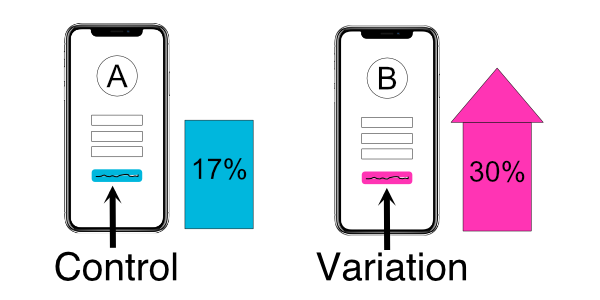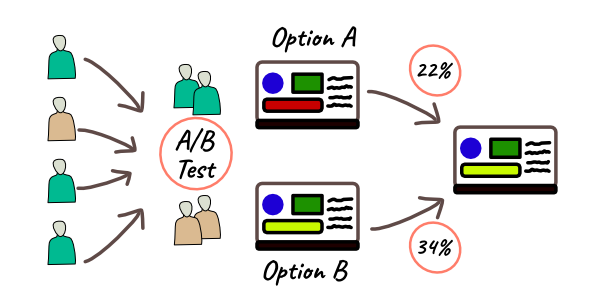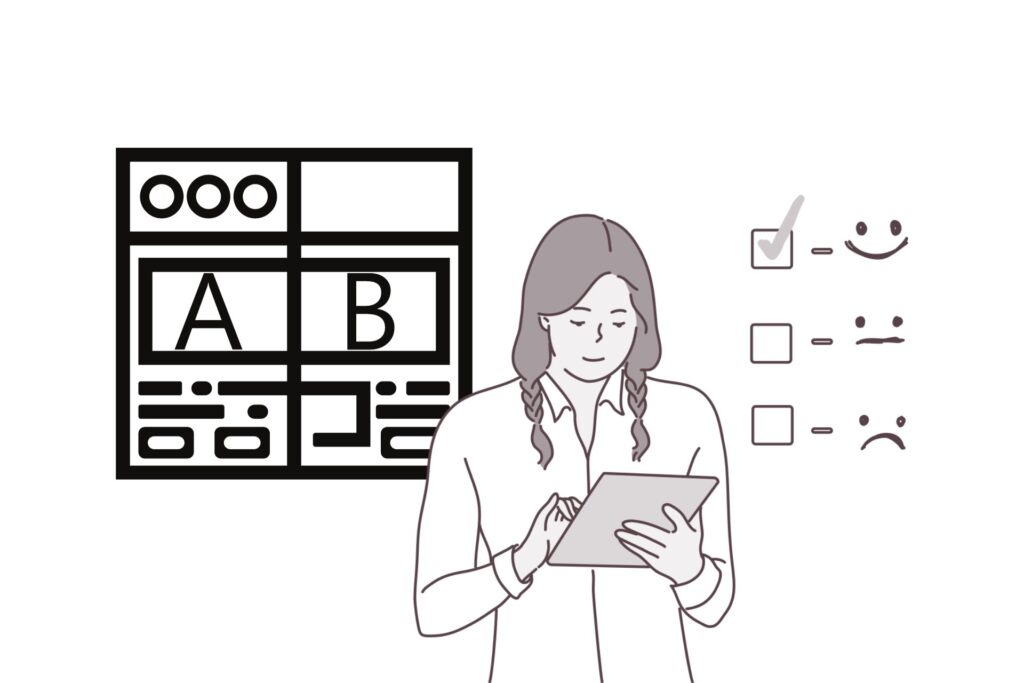What is A/B Testing
A/B testing, aka split testing, is a marketing method used to optimize our marketing performance by comparing two versions of a web page or any marketing related asset (email, ad, pop up, app, etc.). Basically we test two different variants on two separate groups and after a test and measurement process we find out which one performs better.
In this comparison, the original version (A) is “control” and the second (B) is “variation”. Based on the results we gather from these two groups we find out which title, CTA button color or position, copy or page structure delivers more conversion.

Why you should A/B test
As a marketer you know about your audience’s pain points and needs. And you are in a constant developing process to deliver the best service. Furthermore, through deep research you create perfect marketing strategies and as part of your marketing campaigns you create amazing content. But it doesn’t mean that people are aware of that.
To attract your audience you also need to evoke the urge to act; be it clicking on your ad, blog post, purchase link, contact button, email or whatever it is that you want them to do. Only when they do it, will the strangers (attract step) convert into prospects and move up the marketing funnel.
To evoke this urge, you need to try a continual testing process and come up with the best drive that will get them into action. It should be supported by the determining factors they’ll like most in terms of function, color, type, ease of use and others.
While it may seem rather simple and obviously not going to work for your business due to its simplicity, A/B testing in essence provides many benefits for any for-profit business. And these apply to all marketing efforts, not just the web page.
Reduce bounce rate:
Bounce rate is a metric that measures the percentage of visitors who leave your website after viewing only one page. It reflects the number of visitors who “bounce” or exit from your website, instead of exploring it further.
A/B testing allows you to experiment with different versions of your web page and content, in order to find the best performing version. It helps you to make changes that will result in visitors spending more time on your website, and increases the likelihood of them taking a desired action, such as making a purchase or filling out a form.
Increased website traffic:
For example, by testing two different headlines, you may find that one headline has a higher click-through rate, indicating that it is more effective at attracting visitors to your website. Once you know which elements are working well, you can optimize your website to focus on those elements, which can result in an increase in website traffic.
Additionally, A/B testing allows you to improve the user experience, reduce bounce rate, and increase conversion rates, all of which could lead to an increase in website traffic.
Improve ROI:
A/B testing can provide a high return on investment, as even the smallest changes can result in a significant boost in conversions.
Acquiring high-quality traffic for a website can be costly. It enables you to extract the most value from your current traffic, without the need to invest additional funds in acquiring new visitors. It allows you to improve conversions by making small adjustments to your website, which can lead to a significant increase in overall business conversions.
Increased email open/click-through rate:
You can improve email open and click-through rate by testing different elements of your emails, such as subject line, sender name, email layout, and call-to-action. By testing different versions of these elements, you can identify which ones are most effective at capturing the attention of your subscribers and encouraging them to open and engage with your emails.
For example, you can test different subject lines to see which one has a higher open rate, or test different call-to-action buttons to see which one has a higher click-through rate.
By identifying the elements that perform best, you can optimize your emails to focus on those elements, which can lead to an increase in open and click-through rates.
Besides, A/B testing allows you to test the best time to send the email, the best segment of the audience to target, and the type of content that resonates with the audience. These insights can also help to improve the open and click-through rate.
Better pop up performance:
You can A/B test different pop-up designs to see which one has a higher conversion rate, or test different timing to see which one has a higher interaction rate. You can also test different messages and calls-to-action to see which one resonates best with the audience.
By identifying the elements that perform best, you can optimize your pop-up to focus on those elements, which can lead to an increase in engagement and conversion rates. Additionally, it allows you to test the best placement, trigger, and frequency of the pop-up on the website, which can also help to improve the performance of the pop-up.

What you can A/B test
There are a number of different elements that you can test in order to optimize the performance of your website or online marketing campaigns. Some of the most common elements that are A/B tested include:
Title: The title of a webpage or email is often the first thing that a visitor will see, and it can be a crucial factor in determining whether or not they continue to engage with the content. A/B testing different titles can help you to identify which one is most effective at capturing the attention of your audience and encouraging them to continue reading.
Call-to-action: A call-to-action (CTA) is an element that encourages visitors to take a specific action, such as signing up for a newsletter or making a purchase. A/B testing different CTAs can help you to identify which one is most effective at encouraging visitors to convert.
Forms: Forms are often used to capture information from website visitors, such as their name and email address. A/B testing different form designs, layouts, and fields can help you to identify which elements are most effective at encouraging visitors to complete the form.
Images: Images can be a powerful tool for capturing the attention of website visitors and encouraging them to engage with your content. A/B testing different images can help you to identify which ones are most effective at achieving your goals.
Page structure: The structure of a web page can have a big impact on how visitors interact with the content. A/B testing different page structures can help you to identify which layout is most effective at encouraging visitors to engage with your content.
Landing pages: Landing pages are the first page a visitor sees when they arrive at your website, usually through an ad or a specific link. A/B testing different landing page designs, layouts, and elements can help you to identify which one is most effective at encouraging visitors to convert.
PPC ads: Pay-Per-Click (PPC) ads are a popular way of driving traffic to your website. A/B testing different ad copy, images, and targeting can help you to identify which elements are most effective at driving clicks and conversions.
Email: Email marketing is a powerful tool for engaging with your audience, but it can be difficult to get your message across. A/B testing different subject lines, sender names, and email layouts can help you to identify which elements are most effective at encouraging opens and clicks.
Pop-up: Pop-ups are a great way to capture leads, promote products, or drive conversions. A/B testing different pop-up designs, layouts, messages, and triggers can help you to identify which elements are most effective at engaging your visitors and driving conversions.
By A/B testing these different elements, you can gain valuable insights into what works best for your audience, which can help you to optimize your website, marketing campaigns, and improve your overall ROI.
How A/B testing works

Research and identify goals
To start testing, gather information and set clear objectives. Analyze your data to pinpoint areas that need improvement, such as pages with low conversion or high exit rates. Prioritize testing on high-traffic pages to quickly gather data. Your objectives, or conversion goals, are the metrics used to determine if a variation is better than the original. These could include actions like clicking a button, making a purchase, or signing up for emails.
Generate hypothesis
To achieve your business goals through A/B testing, it is important to conduct research, log observations and create data-backed hypotheses to increase conversions.
By analyzing data, making observations, and drawing website and user insights, you can formulate data-backed hypotheses. Once a hypothesis is ready, test it against various parameters such as the likelihood of success, impact on macro goals and ease of setup. Before you begin A/B testing, review your data again to identify patterns to develop ideas about why certain content performs better than others. This will help you develop a hypothesis for your test, which is an informed guess about the results of making specific changes to your content during the test.
Create variations
To test your hypothesis, create different versions of your current content. These variations should be based on the hypothesis you have formed.
For example, you could try a variation of the “ask for a quote” form by omitting the phone number field or adding a downloadable catalog.
Keep in mind that while creating variations, only one element should be changed, all other elements like the title, ad copy and landing page should remain the same during the test.
Run test
Start your A/B test by assigning visitors to either the control or variation group randomly. As they engage with each version, track, record and analyze their actions to evaluate which one performs better.
Analyze results
After your experiment is completed, evaluate the results by looking at metrics you determined for your test. Based on this analysis, if the test yields successful results, implement the winning version.
Repeat
The first round of A/B testing may bring you closer to your desired conversion outcomes, but it’s common to have to revise your hypothesis and repeat the process with new variations. This repetitive approach is necessary for ensuring that your marketing strategy is on track to meeting your goals. In some instances, you may have to reconsider your goals if they are excessively optimistic.













